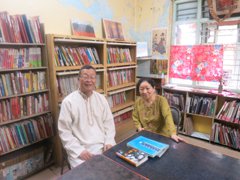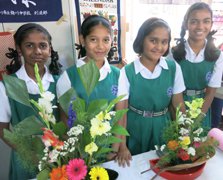Japanese-Language Education Developing in India Alongside Strong Japan-India Relations
The Japan Foundation, New Delhi (West India)
HIRAGA Tatsuya
Relations between Japan and India have been improving rapidly since former Prime Minister Koizumi visited India in 2005. This has led to a rise in direct investment by Japanese companies, and the number of Japanese language learners is rising as well.
Whereas the number of Japanese learners in India was just 5,446 in the Survey Report on Japanese-Language Education Abroad 2003 by the Japan Foundation, that number rose to 24,011 in the Survey in 2017. That is an increase of approximately 3.5 times over the 2003 number.
Focusing on West India, we see that the number of participants for the Japanese-Language Proficiency Test (JLPT) reached approximately 4,000 people in July of this academic year between the Pune test site (with 3,000 people) and Mumbai test site (with 1,000 people). This is the highest number since we began holding the JLPT twice per year. As we can see, the need among West Indians to study Japanese is rapidly growing, caused in part by a major rise in recent years in opportunities for Indians to work at Japanese companies. Examples of this trend include Japan based personnel scouting companies focusing on offshore talent coming to Pune to call for applicants, and both Japanese and Indian companies with international reach visiting universities and other educational institutions which offer Japanese-language education to recruit students directly on campus. Keeping up with the trend, the number of colleges in Pune opening Japanese courses is rising as well, particularly at technical colleges. The level of Japanese learners and teachers is particularly high in Pune, which also demonstrates the ongoing development of Japanese-language education here.
There are many factors that have led to this development here in Pune. The first reason is that Pune has traditionally been home to a large number of educational institutions. In other words, one could say that the residents of Pune like to learn in general, and students of foreign languages have traditionally studied very hard here. In a way, I get the sense that learning is almost a hobby for the people of Pune.

With Ms. TENDULKAR Michiko (at her home)
Another reason is the efforts of the young teachers who have been deployed here as part of the Japan Overseas Cooperation Volunteers (JOCV) since the 1970s. One notable contributor is Ms. TENDULKAR Michiko who was first deployed to Mumbai (formerly Bombay) from 1970 to 1972, and then went on to teach at the Indo Japanese Association (IJA) in Pune from 1976 to 1978. She later returned to Pune in 1981 to teach Japanese at the Department of Foreign Language Studies, Pune University, after which she was instrumental in the establishment of the Japanese Language Teachers’ Association, Pune (JALTAP) in 1993. During that time, she also established a Japanese library in her home which was available to students. This enabled Japanese learners in Pune to study independently, allowing talented students to grow and creating fertile soil for the cultivation of talented Japanese-language teachers. It is safe to say that the majority of the top-level teachers teaching in Pune today were students of Ms. TENDULKAR Michiko. This demonstrates how it would be impossible to talk of the development of Japanese-language education in Pune without mentioning her passion and efforts. Even today she continues to enjoy teaching Japanese children’s songs and speak about Japanese culture to young learners.

Exhibition of Japanese culture at an elementary school (Ahilyadevi High School for Girls)
Vigorous Japanese cultural activities are also being carried out in Mumbai by the Teachers’ Association of Japanese (TAJ). Meanwhile in Pune, Japanese singing contests are being held at Pune University and the Tilak Maharashtra Vidyapeeth (University) (TMV). There are also “Region-Wide Japanese Singing Contests” held in West India primarily by IJA and TAJ. Meanwhile, numerous exhibits are held at the various educational levels, from elementary to universities, to introduce Japanese culture. Interest in Japanese language and culture is particularly rising at the elementary and secondary levels. I myself receive numerous requests to attend such events in Pune itself and the surrounding suburbs. In response, I make an effort to generate interest in Japanese culture by introducing Japanese children’s songs and activities. My expectation is that these types of extracurricular Japanese classes introducing Japanese culture will spread further in Pune.
Due in part to the declining birthrate, Japan currently faces a shortage of young engineers studying at tech-oriented universities. But in India, the population of youth is high and there are many talented people. Young Indian talent will likely be in increasing demand to fill the blank left by the personnel shortage in Japan. While we are few in number, the Japanese-Language Specialists are cooperating with the vast country of India to cultivate Japanese speakers on a daily basis.
- What We Do Top
- Arts and Cultural Exchange [Culture]
- Japanese-Language Education Overseas [Language]
- Japanese-Language Education Overseas [Language] Top
- Learn Japanese-language
- Teach Japanese-language
- Take Japanese-Language Test
- Know about Japanese-language education abroad
- The Japanese-Language Institute, Urawa
- The Japanese-Language Institute, Kansai
- Japanese-Language Programs for Foreign Specified Skilled Worker Candidates
- Japanese Language Education for Japanese Children Resident Overseas and for the Descendants of Migrants
- Archives
- Japanese Studies and Global Partnerships [Dialogue]
- JF digital collection
- Other Programs / Programs to Commemorate Exchange Year
- Awards and Prizes
- Publications
